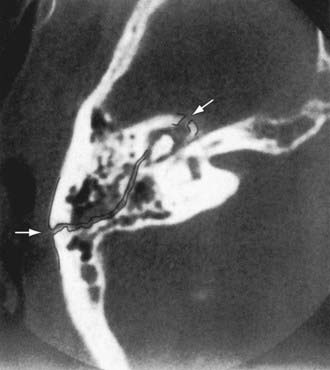Chapter 634 Traumatic Injuries of the Ear and Temporal Bone
Auricle and External Auditory Canal
After a foreign body is removed from the external canal, the TM should be inspected carefully for possible traumatic perforation or for a pre-existing middle-ear effusion. If a foreign body has resulted in acute inflammation of the canal, eardrop treatment as described for acute external otitis should be instituted (Chapter 631).
Temporal Bone Fractures
Children are particularly prone to basilar skull fractures, which usually involve the temporal bone. Temporal bone trauma should be considered in head injuries, and the status of the ear and hearing should be evaluated. Temporal bone fractures are divided into longitudinal (70-80%), transverse, and mixed. Longitudinal fractures (Fig. 634-1) are commonly manifested by bleeding from a laceration of the external canal or tympanic membrane; postauricular ecchymosis (Battle sign); hemotympanum (blood behind an intact TM); CHL resulting from TM perforation, hemotympanum, or ossicular injury; delayed onset of facial paralysis (which usually improves spontaneously); and temporary CSF otorrhea or rhinorrhea (from CSF running down the eustachian tube). Transverse fractures of the temporal bone have a graver prognosis than longitudinal fractures and are often associated with immediate facial paralysis. Facial paralysis might improve if caused by edema, but surgical decompression of the nerve is often recommended if there is no evidence of clinical recovery and facial nerve studies are unfavorable. If the facial nerve has been transected, surgical decompression and anastomosis offer the possibility of some functional recovery. Transverse fractures are also associated with severe SNHL, vertigo, nystagmus, tinnitus, nausea, and vomiting associated with loss of cochlear and vestibular function; hemotympanum; rarely, external canal bleeding; and CSF otorrhea, either in the external auditory canal or behind the TM, which can exit the nose via the eustachian tube.
Fasunla AJ, Ogunleye OO, Ijaduola TG. Healthcare givers’ skill and foreign bodies in the ears of children in the tropics. Int J Pediatr Otorhinolaryngol. 2007;71:191-195.
Hough JVD, Stuart WD. Middle ear injuries in skull trauma. Laryngoscope. 1968;78:899-937.
Matsuda Y, Kurita T, Ueda Y, et al. Effect of tympanic membrane perforation on middle-ear sound transmission. J Laryngol Otol. 2009;123(Suppl 31):81-89.
Osman EZ, Swift A. Management of foreign bodies in the ears and upper aerodigestive tract. Br J Hosp Med. 2007;68(11):M189-M191.
Pawelczyk M, Van Laer L, Fransen E, et al. Analysis of gene polymorphisms associated with K ion circulation in the inner ear of patients susceptible and resistant to noise-induced hearing loss. Ann Hum Genet. 2009;73(Pt 4):411-421.
Saraiya PV, Aygun N. Temporal bone fractures. Emerg Radiol. 2009;16:255-265.







